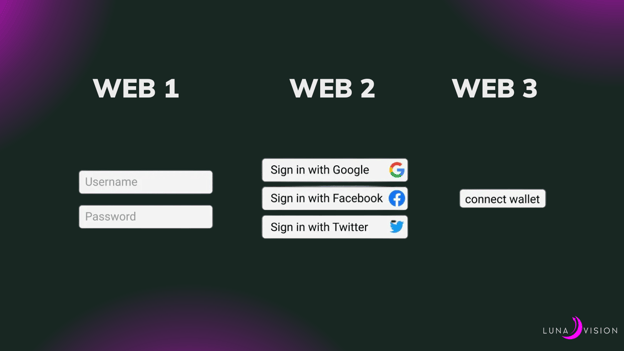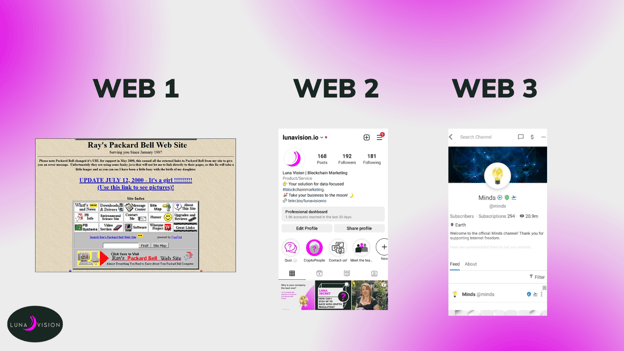Are you curious about the future of the internet? If so, you might want to know about Web3 - the latest stage of internet evolution. It aims to create more fair and user-controlled online communities, and it's doing it with the help of blockchain technology! But what is the difference between Web1, Web2, and Web3? And is the technology behind it still progressing? Don't worry, we got you covered.
Author: Carmen Rodriguez
Differences between Web1, Web2, and Web3
The development of the internet has gone through several stages of evolution. We commonly refer to these stages as Web1, Web2, and Web3. Web1 was the early phase when websites were basic and limited in functionality. Web2 brought about significant advancements as it allowed users to generate content and engage in online conversations. The current stage, Web3, is still in progress, but its focus is on leveraging blockchain technology to build online communities that prioritize fairness and user autonomy. As you can see in figure one, these developments also manifested in the way we access platforms.
 Figure 1: Evolution of log in methods
Figure 1: Evolution of log in methods
A good way to understand this is by taking a look at the evolution of social media:
- Web1 social media platforms: Geocities and Usenet. These sites were largely one-way communication tools, with users creating content that could be viewed by others, but not easily shared or interacted with.
- Web2 social media platforms: Twitter, and Instagram. They allowed users to create and share their own content, connect with other users, and participate in online communities. The ability to comment on and share content also made these sites more dynamic and engaging, facilitating real-time conversations and spreading information.
- Web3 social media platforms: Steemit, Minds and Nostr. These platforms aim to create more equitable and user-controlled online communities, where users are rewarded for their contributions and have greater control over their data. The decentralized nature of these platforms also means that they are less vulnerable to censorship or control by centralized authorities.

Figure 2: Visual evolution of social media platforms
The change in design of these platforms, that you can see in figure 2, is more drastic from Web1 to Web2. However, the underlying technology powering these platforms has evolved significantly.
Enhancing User Experience through Hybrid Projects in Blockchain Technology
The development of blockchain technology has led to the emergence of several hybrid projects that combine traditional web technologies with blockchain technology, referred to as Web2.5. While these projects are not yet fully Web3, they provide a higher level of decentralization, transparency, and security compared to traditional Web2 applications. Examples of Web2.5 projects include Brave Browser and BitTorrent, which integrate blockchain technology to improve their user experience and offer enhanced privacy and security.
Instagram, one of the most popular social media platforms, has also incorporated elements of Web2.5 by introducing the option of Non-Fungible Tokens (NFTs) on user profiles, they call it Digital Collectibles. While NFTs themselves are a decentralized feature, as the tokens represent unique ownership of digital assets on the blockchain, the structure in which they are displayed on Instagram's platform is not entirely decentralized. Therefore, Instagram can be considered an example of a Web2.5 project, as it combines traditional web technologies with blockchain technology to provide users with new and innovative features, while still maintaining a centralized structure for its platform.
Where do we stand with the technology behind Web3?
In 2022, the crypto and token markets experienced a major crash, leading many to question the future of blockchain technology. However, in 2023, it's become clear that this setback hasn't stopped blockchain from pushing forward. NFT games, metaverse platforms, and decentralized finance (DeFi) are just a few examples of how blockchain is being used to create innovative new applications. Companies across industries are also exploring the potential of blockchain for streamlining operations and creating new business models.
According to the 2023 Gartner Hype Cycle for Blockchain and Web3 (see Figure 3), blockchain technology is now entering the "Slope of Enlightenment" phase, where its benefits and limitations are better understood and its potential for mainstream adoption is being realized.
.png?width=1600&height=900&name=Web%201%20(4).png)
Figure 3: Gartner Hype Cycle for Blockchain and Web3
As more and more people take steps to manage risks associated with blockchain, we're getting closer to a tipping point where this technology will really take off. It's truly exciting to think about all the possibilities for the future! In fact, some argue that the market crashes caused by corrupt players could have been avoided if decentralized finance had been in place, where no single party had control. This highlights the potential benefits of decentralized systems, and why they could be key to unlocking the full potential of blockchain.
The Rise of Web3 Marketing
The rise of blockchain technology has not only created innovative new applications, but it has also created a necessity for web3 marketing. Blockchain-based platforms and applications offer unique features like transparency, security, and decentralization, which require a new approach to marketing. Blockchain marketing seeks to leverage these features to communicate with consumers, build trust, and promote adoption; while speaking the communities unique “language” and keeping up with the new developments happening fast.
As blockchain technology becomes more known to the masses, companies that adopt web3 marketing will have an advantage in building relationships with their customers and standing out in a crowded market. With its potential for creating a more equitable and transparent digital world, blockchain technology is driving the need for blockchain marketing as an essential component of the digital marketing landscape.
About Carmen Rodriguez
Carmen Rodriguez is a social media manager at Luna Vision and executive assistant at basenode.io. Before that, she worked for other companies in the marketing field. Besides her degree in business administration, she holds a master's in social innovation. She is an alumna of the DLT Talents program, well connected in the Berlin web3 ecosystem. You can reach out to Carmen via LinkedIn.
About Luna Vision
Luna Vision is a blockchain marketing agency with its roots in the blockchain ecosystem. We offer data-focused marketing to blockchain startups. With a deep understanding of blockchain technology, we can best promote your products created and running within the blockchain ecosystem and “translate” to your customers - may they be already included in the ecosystem or still be new here.
Share this
You May Also Like
These Related Stories
.png?width=1920&height=1080&name=Luna%20Explanations%20(24).png)
The Future of E-commerce: Web3's Impact on Online Shopping
-1.png?width=1920&height=1080&name=Luna%20Explanations%20(28)-1.png)
Meme Magic: How Memes Are Shaping Web 3 communities
.png?width=1600&height=900&name=Green%20And%20Black%20Modern%20Podcast%20Cover%20(Post%20de%20Twitter).png)


.png?width=1080&height=1080&name=The%20Role%20of%20Social%20Media%20Marketing%20in%20Crypto%20Start-ups%20(16).png)

No Comments Yet
Let us know what you think